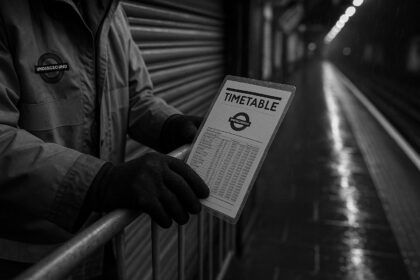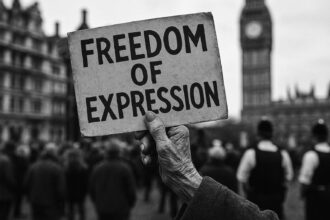Following the Supreme Court’s definition of ‘woman’ and ‘sex’ based on biological characteristics, Police Scotland faces growing criticism over delayed policy reforms on gender identity, raising concerns about the impact on public confidence and operational integrity.
Public confidence in policing across Scotland is increasingly under scrutiny as concerns mount regarding the implementation of a crucial Supreme Court ruling that defines ‘woman’ and ‘sex’ exclusively in terms of biological characteristics. The ruling has prompted questions about whether rapists can self-identify as women—a point raised fervently by Katharina Kasper, a board member of the Scottish Police Authority (SPA). Ms Kasper’s remarks highlight a perceived ‘policy vacuum’, suggesting that the lack of decisive action may be undermining public trust in Police Scotland.
In April, the Supreme Court delivered a groundbreaking judgment clarifying the definitions within the Equality Act 2010, stating unequivocally that these terms pertain solely to biological sex. This ruling has profound implications for policing, particularly regarding the handling of gender identity claims in serious cases such as sexual offences. Despite the gravity of the court’s decision, the SPA received only an ‘interim’ report on the progress of policy updates—a move described as ‘disappointing’ by Ms Kasper.
Scottish Conservative equalities spokesman Tess White echoed these sentiments, asserting that even board members of the SPA are voicing concerns over Police Scotland’s inertia in responding to mandated legal obligations. She stressed the urgency for SNP ministers to issue directives ensuring compliance across all public bodies, insisting that these actions are vital for maintaining public confidence in policing decisions.
Amidst this backdrop, Police Scotland has initiated a comprehensive review of its policies to ensure alignment with the Supreme Court ruling and to reassess its practices regarding the recording of gender and sex data. Assistant Chief Constable Catriona Paton noted the importance of adhering to equality, human rights, and data protection laws while fulfilling operational requirements. Nevertheless, the ongoing uncertainty about how gender is recorded remains a critical issue within the police ranks, with fears that ambiguity may further erode public trust.
The situation is compounded by a wider dialogue surrounding Scotland’s Hate Crime and Public Order (Scotland) Act 2021, which has drawn criticism for its potential impact on public trust in policing. Senior officials, including Rob Hay, president of the Association of Scottish Police Superintendents, voiced apprehensions that the new law might lead to a deluge of complaint reports, adding to the strain on police resources. This legislative framework has stirred fears that it could result in officers being caught in contentious disputes over allegations of hate crimes, particularly with respect to transgender identities.
In response to the Supreme Court ruling, various government ministers, including Pat McFadden, have addressed concerns about its ramifications on public facilities, including those designated for single-sex use. While assurances against excessive policing of facilities, dubbed as ‘toilet police’, have been made, the ruling undoubtedly raises questions about applicable policies and operational practices in light of the new legal definitions.
Following past criticisms, Police Scotland has committed to consulting with women’s groups to ensure its policies align with both legal standards and community expectations. The implications of allowing individuals charged or convicted of serious crimes to claim a gender identity through self-declaration have led to significant backlash, labelled as ‘deeply offensive’ by concerned campaigners. The potential for these policies to misrepresent crime statistics adds further urgency to the need for review and reform.
As the complexities surrounding gender identity in policing continue to unfold, the assurance sought by both officers and the public that sound policies underlie operational practices remains paramount. While Scottish authorities strive to navigate the intricacies of these issues, the tug-of-war between legal obligations, public trust, and individual rights is likely to persist, demanding careful negotiation and transparent dialogue.
 Reference Map:
Reference Map:
- Paragraph 1 – [1], [2]
- Paragraph 2 – [1], [6]
- Paragraph 3 – [2], [3]
- Paragraph 4 – [4], [5]
- Paragraph 5 – [7]
- Paragraph 6 – [6], [1]
Source: Noah Wire Services
- https://www.dailymail.co.uk/news/article-14799653/Publics-confidence-Police-Scotland-damaged-gender-ruling-inaction.html?ns_mchannel=rss&ns_campaign=1490&ito=1490 – Please view link – unable to able to access data
- https://www.scotsman.com/news/politics/police-scotland-orders-policy-review-in-wake-of-supreme-court-gender-definition-ruling-5090341 – Following the Supreme Court’s ruling that ‘woman’ and ‘sex’ in the Equality Act 2010 refer to biological sex, Police Scotland announced a review of its policies on transgender issues. The review aims to align with the judgment and revised national guidance, considering terminology and recording practices related to sex and gender data. Assistant Chief Constable Catriona Paton emphasized the importance of this work in ensuring compliance with equality, human rights, and data protection laws while meeting operational requirements.
- https://www.theguardian.com/uk-news/2024/apr/01/hate-act-will-lessen-public-trust-in-the-force-says-scottish-police-chief – Scotland’s First Minister, Humza Yousaf, defended the Hate Crime and Public Order (Scotland) Act 2021 amid criticism that its enforcement could diminish public trust in policing. The Act creates a new offence of ‘threatening or abusive behaviour that is intended to stir up hatred’ on various grounds, including transgender identity. Critics, including the Scottish Police Federation, expressed concerns that the law’s implementation might lead to a surge in complaints and place additional strain on police resources.
- https://www.telegraph.co.uk/news/2024/03/31/scotlands-hate-crime-law-could-damage-public-trust-police/ – Senior officers have warned that Scotland’s new Hate Crime and Public Order (Scotland) Act 2021 could damage public trust in the police. Rob Hay, president of the Association of Scottish Police Superintendents, highlighted concerns about a potential surge in hate crime reports, driven by individuals seeking to exploit the legislation. He noted that police officers would be caught in the middle, with those accused of hate crimes feeling aggrieved if their details are recorded by police, even if there is no prosecution.
- https://www.scotsman.com/news/politics/gender-ruling-toilet-police-sturgeon-5101462 – In response to the Supreme Court’s ruling on the legal definition of a woman, Cabinet Office Minister Pat McFadden stated that there are no plans for ‘toilet police’. He acknowledged the need for the government to adapt its practices following the judgment but dismissed the notion of policing toilets. The ruling clarified that ‘woman’ and ‘sex’ in the Equality Act 2010 refer to biological sex, prompting discussions on the implications for single-sex facilities and services.
- https://murrayblackburnmackenzie.org/2024/09/30/transitioning-at-work-how-police-scotland-gave-cross-dressers-an-access-all-areas-pass/ – Murray Blackburn Mackenzie examines Police Scotland’s ‘Transitioning at Work’ policy, which allows individuals to self-declare their gender identity without providing evidence or certification. The policy has been criticized for potentially allowing male individuals to access female spaces, raising concerns about the impact on women and the potential for legal challenges. The article discusses the legal complexities surrounding gender recognition and the responsibilities of public bodies in balancing rights and duties.
- https://www.heraldscotland.com/news/24568745.police-scotland-face-backlash-gender-id-policy/ – Police Scotland faces criticism for allowing individuals charged or convicted of rape to self-declare their gender identity, leading to potential misrepresentation in crime statistics. The policy, which permits self-declaration without evidence, has been described as ‘deeply offensive’ by campaigners. The force has committed to reviewing its policies and engaging with women’s groups to address concerns and ensure alignment with organizational values and legal obligations.













